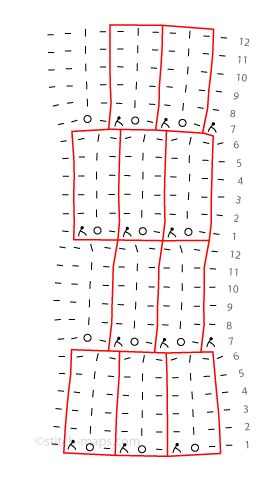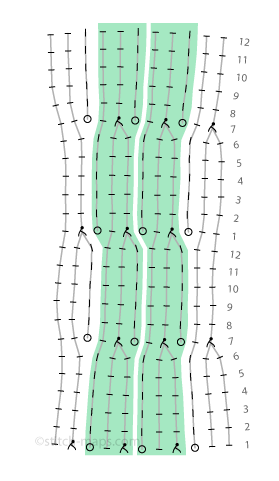Mandy Moore's Blog, page 53
April 14, 2015
Jillian’s not Spinning: Rebecca Ringquist Embroidery Book Giveaway
I learned to embroidery from Rebecca Ringquist’s Creativebug class and I haven’t stopped stitching since. I’ve spent a year stitching her samplers and stitching on just about everything I can get a needle through. She is a creative hero of mine.
I am so excited that she has a new book out!
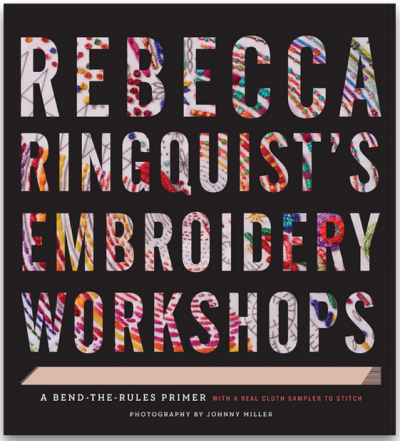
Creative inspiration!
I reviewed the book in this issue of Knitty:
Rebecca Ringquist’s Embroidery Workshops
by Rebecaa Ringquist
STC /A Melanie Falick Book
$29.95, hardcover
Rebecca Rinquist’s mantra for teaching embroidery is “Don’t worry, just stitch”. This book is like no other how-to embroidery and for that I am very grateful.
I learned to embroider from Rebecca a few years ago through her Creativebug class and it was exactly the revelation I wanted. Embroidery doesn’t have to be a litany of do this, exactly this way and no knots ever; it can be as relaxed a creative pursuit as I wanted it to be.
This book is filled with exceptional teaching and beautiful examples of embroidery, and it opens with a photo of the back of a sampler stitched by Rebecca herself. Guess what it shows? Knots, and threads stretched from one working area to another, not the “back should be as clean as the front” school of embroidery.
Rebecca teaches the basics of embroidery stitches using a sampler (included in the book). In her teaching, she takes the rich tradition and history of embroidery in a new modern, relaxed direction.
This book is divided into four main sections: Stitch, Trace, Draw and Layer. Stitch breaks down the families of stitches how to create basic stitches and how to make many variations. Trace explains a variety of ways to transfer images to embroider, including the best methods for different fabrics. Draw teaches the basics of mark making, creating original images or lines as a supplement to an existing design or as a freehand design on fabric. Layer explores methods of embroidering over already embroidered fabrics.
Each section has several projects designed to instantly try out the lesson taught in the chapter. They range from ones that can be completed in an afternoon to ones that require thought and the possible scouring of flea markets. Highlights for me are the Single-Stitch Patches, Portrait Napkins, Angela’s Stitch Doodle Bracelets and the 3D Embroidered Buckle Brooches.
The main sections are bookended with a beginning chapter on Supplies, including supplies for machine embroidery and an ending chapter on Finishing: how to mount, frame, stretch and hang your work.
All of the how-to is overflowing with step-by-step illustrations and photography. It is abundantly clear what to do and what it should look like when you are finished.
The book is packed with beautiful pictures of embroidery, particular stitches, projects to make, Rebecca’s mixed media art and all the color and texture of embroidery supplies. It is impossible to look through this book and not want to play along.
I have one copy of Rebecca’s beautiful book to giveaway. Leave a comment before Sunday April 19th 2015 to be entered for a chance to win!

April 10, 2015
Spring & Summer Issue WIPs & FOs
CanadianNeedles‘ Mylui Lino top is coming along nicely. This just makes me crave warm summer sunshine.

Simple elegance. A great yarn substitution!
FiatKnitter‘s Mia tank is coming along well.

Fantastic colour choice.
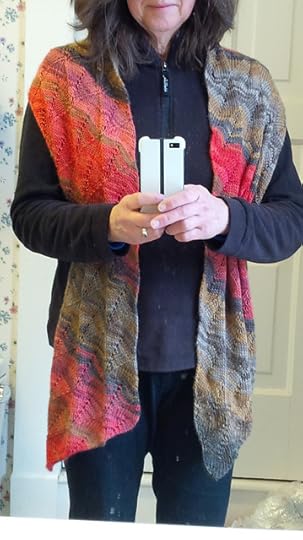
A minor variation – narrower to make sure the knitter had enough yarn. But just as wonderful!
And I adore this version, in handspun.

Can’t wait to see it grow.
Love these rainbow-tastic Geek Socks by OnlyLouise.

So much fun!
And this close-up of the lace and beads gets me very excited about TNTknit‘s Hybrid Vigour project.

Beautiful yarn and bead combo. Subtle and sophisticated.

April 8, 2015
WWW: Readings on the Ethics of Wool; Fun Facts About Sheep; On Yarn Substitutions
A very helpful and clear guide to yarn substitutions… an excerpt from Margaret Radcliffe’s book ‘The Knowledgeable Knitter‘.

Everything you need to know, in one image. (Borrowed from the Berroco yarns website.)
Another important topic: on measuring yourself for a garment, by Amy Christoffers on the Berroco yarns blog.
Top Ten Facts about Sheep. I think the first one is the best…
Sheep have excellent memories for the faces of both other sheep and humans which they can remember for several years.
If you follow me on Twitter, you’ll know that I’ve had a couple of conversations recently about the issues of animal welfare as it relates specifically to wool. In the last few weeks, I’ve been asked by a few people – some knitters, some not – about the ethics of wool. I honestly didn’t feel sufficiently well informed to speak to their concerns. I am, of course, sensitive to animal welfare issues. But I also know that there is a lot of misinformation floating around, and a lot of confusion about a very complex and layered issue. And it’s an emotional issue, too. I feel strongly that, just as with meat-eating and fur-wearing, everyone must make their own decision about it. I do believe the best approach is to learn as much as you can.
When chatting about this on Twitter, fiber expert Deb Robson weighed in with a pointer to a blog post she’d written on this topic a number of years ago, and then created a blog post from a recent email exchange.
Some other good reading: The Guardian’s ethics and green living experts, answering a reader’s question on the ethics of wool.
No matter your own feelings on wool/meat-eating/fur and other related topics, I think it’s fair to say that the vast majority of those in the fiber industry agree that “large-scale, industrial production harms animals, humans, and the planet” (Deb’s words, she puts it so well.) Not all producers engage in the same practices, and in this, as with everything, information is your best ally.
Related: I did rather enjoy this picture, found on Twitter.
A vegetarian lamb dish
pic.twitter.com/jdnSi4JAju
— Ben (@bjm2000uk) April 5, 2015

April 7, 2015
Jillian’s Spinning: Classes in My Own Backyard

It really is shaped like a mitten!
I am guilty of ignoring things that go on in my own fiber backyard. I dream of Maryland Sheep and Wool, Rhinebeck, Taos, Madrona, but events that are closer to home I tend to ignore. I’m not sure why. Maybe because they don’t seems as special if I’m not traveling for days (and spending all that extra money to travel)? This year it changes. In August I’m going to take classes at the Michigan Fiber Festival.
It looks like there are 60 classes to choose from. There are several classes that I want to take and most of them are at the exact same time, so I’m mulling. I know I want to take one of the weaving classes offered and a spinning class with Ester Rogers, beyond that it’s still misty.
Are you taking classes close to home this year?

April 3, 2015
On Hybrid Vigour & A Traditional Shawl Variation
Have you see the beautiful cover design in the latest issue? Mary-Anne Mace’s Hybrid Vigour. It’s a hybrid design, in that it’s a shawl that is partially closed, to be worn like the most elegant poncho ever.
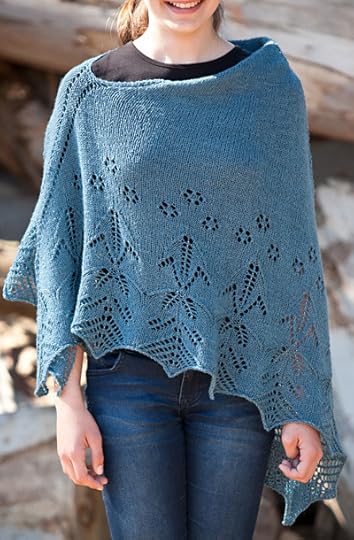
A poncho, but not a Poncho, y’know?
I mean, I do like a poncho. They’re particularly great at this time of year – for transitional weather. But I wouldn’t use the word elegant to describe them. Mary-Anne has made a practical thing beautiful. And we love her for it.
Of course, you might want to just wear it as a shawl, too. Mary-Anne has kindly produced notes and instructions on how to work it flat, if you’re so inclined.

Just beautiful!
April 2, 2015
Obsession Thursday: Conquering slipperyness
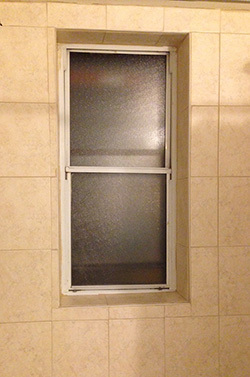
Who puts a window INSIDE a shower? Well, it’s mine and I’m gonna keep it clean, dangit.
You may think this post is about knitting. It is not. It is about sticking things to a tiled surface.
Said tiled surface, in this case, is the wall of my shower. And everyone knows you knit happier when you’re clean. Whatever. Work with me here, people.
So I have a completely tiled shower with a big inset window. And everyone in the building puts their shampoos and stuff on that window ledge. I don’t like. It’s messy and unsightly and a breeding ground for mold.
Instead, I wanted to hang up my shower-stuff rack. Maybe it could hang from the shower head, but I don’t find that logical. Don’t want to reach through a stream of water to get at my stuff. The opposite wall is where it belongs. But with a fully tiled wall — HOW?
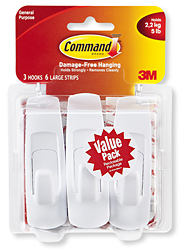
Stupid stupid stupid things. Great when they work. But they often don’t.
Attempt 1 (and 2 and 3): Command hooks. Prepped the surface properly, let it cure for a few days and was thrilled to see it work, for 6 months. Then it failed at 3 am. CRASH BOOM BANG.
Unimpressed.
Prepped attempts 2 and 3 properly as well (including cleaning the wall fully and letting the hook tape set for more than 48 hours before putting weight on the hook). Same thing. Command hooks, you have betrayed me one time too many. You are dead to me.
Then I remembered something I’d seen on a recent shopping trip. A ridiculously over-engineered bit of brilliance. Look at this thing:
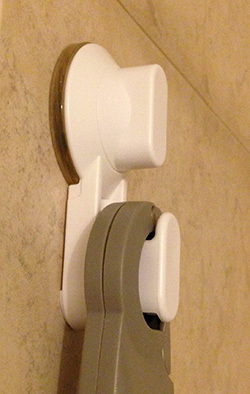
Meet Immeln. Which, as far as can tell, means absolutely nothing in Swedish but seems to have its etymological roots in the word for “fog”. Which is kind of appropriate.
This is another really long caption, isn’t it?
What you have here is Immeln, a line of suction-cup-based hooks by IKEA. What you can’t see is that it works like this:
1. Unscrew the white knob thingy in the front.
2. You will have 3 pieces. A suction cup with a big metal washer and screw in the center, the long white plastic hooky thing and the front white knob thingy that you screwed off in the first place.
3. Clean the surface. (Duh.)
4. Press the suction cup thingy on the wall. Pressy pressy pressy all around the edge of the suction cup thingy to fully adhere it. It’s already a little sticky, too.
5. Cover with the long white plastic hooky thing.
6. Screw the white knob thingy back on. Tightly.
What’s happening? Is that as you screw the thing together, the suction cup is being activated big time as its center is pulled away from the wall. But the outside stays stuckified.
It’s genius. And it’s working.
There’s a whole line of Immeln bathroom stuff, with attached baskets, mirrors and towel rods — but the hooky part they’re currently selling looks very little like the pictures on the IKEA website. I think they’ve done some redesign of the over-designed thingy into its current state, which is fine with me. I’ll gladly pay $9.99CDN for two hooks that actually, really work (that was the price I paid yesterday — not sure why the website is outdated. How very un-IKEA of them!).
Anyway, back to my triumphant success. Wanna see?
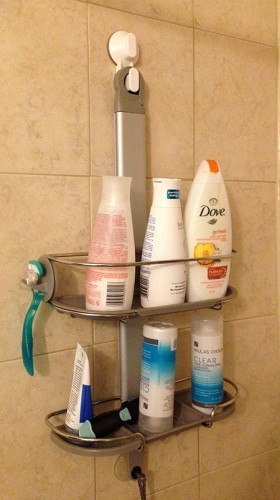
Ta-daaaa! Yes, now you can see my bath products. I don’t think that’s a huge invasion of privacy. It’s not like there’s a bottle of Joe’s Anti-Foot-and-Mouth-Disease body wash on there or nuthing.
Signed,
Your clean and non-frustrated Editor.
P.S. Jillian says I don’t have to write such long blog posts. I keep trying. I’m not doing very well at the brevity part yet.
April 1, 2015
WWW: Textile photography; crafting in space; Bolivian knitters saving lives
Fantastic post on the blog of the Surface Design Association about the importance of good photography, and sharing some tips for textile artists to make sure their photography is the best it can be.
It’s worth getting to know the Surface Design Association, a group out of New Mexico. The group aims promote awareness and appreciation of textile-inspired art and design through publications, exhibitions and conferences. There’s some really lovely and inspiring stuff on their blog.
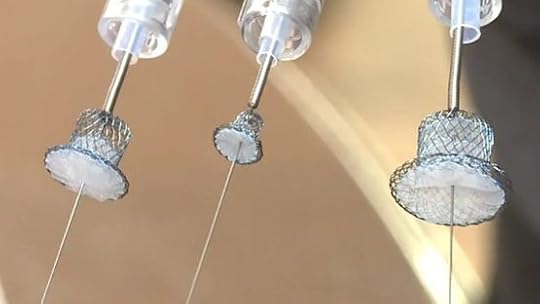
Handmade wonders.
We’ve all heard that knitting is good for your health, and this proves it in a rather unexpected way: Bolivian knitters are helping babies born with heart defects by knitting up tiny occluders to block a hole a patient’s heart. Yes, really. The device is so small and intricate that the industrial equipment were struggling to make them – so cardiologist Franz Freudenthal turned to knitters to help. The knitting is done in a special “clean room” to keep everything sanitary and safe. Amazing story!
Further to the Astro socks, I love this pic of Astronaut Karen Nyberg crafting in space. I know if I was planning for a stay on the ISS, I’d pack yarn and needles.
Pretty much the coolest thing we’ve seen. NASA astronaut @AstroKarenN crafting in space! https://t.co/cbbxeC9t0d pic.twitter.com/yZVRYw8bin
— Let’s Get Crafting (@LetsGetCrafting) March 31, 2015

Ooh… that’s a nice one!
Love this story about the famed cardigans of beloved US children’s TV presenter Mr. Rogers. He always wore a cardigan to host his eponymous show, and we learn that his mother made them for him.
[image error]
Knitting is indeed everywhere in Lithuania!
Knitty columninst Donna Druchunas shares details of her latest project: a book about Lithuanian Knitting traditions. She’s using Pubslush as a way to fund the project through preoders. Even if you’re not sure about preordering or contributing, Donna’s introduction video is interesting, and the traditional knits that Donna shows are really beautiful!
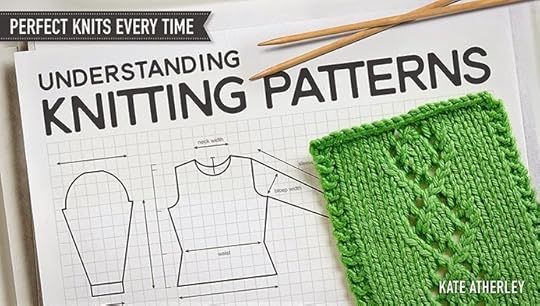
The key to expanding your knitting skills!
Have you heard about my new Craftsy class? “Perfect Knits Every Time: Understanding Knitting Patterns” is designed for knitters who are confident with their yarn and needles, but are just starting to work from patterns.
We’re offering a special 50% discount for our Knitty fans. More info here.
In this class I explain how to understand everything about a pattern: not just how to read the instructions and understand all those special terms and abbreviations, but also
where to find good patterns
how to identify the right pattern for your skill levels
how to make sure you’re using the right needles and yarn for the project
how to understand the sizing information given, and to make sure you always choose the right size to make
how to read and work from charts
The goal is to help you find a pattern that’s appropriate to your skill level and interests, and make sure that you’re able to work through it with ease. Along the way I share tips for working from a pattern, to ensure you not only produce a beautiful finished result, but also that you have a good time doing it!
If you want a sense of what it’s all about this, this video explains.
March 31, 2015
Jillian’s Spinning: My New Website and Fiber Expo
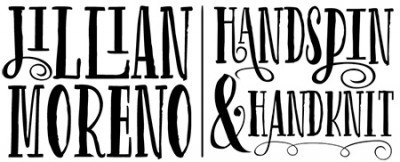
My new logo, like it? Amy designed it!
I have a little bit of exciting news. I’ve launched my own website Jillianmoreno.com and blog. On my website you can see my classes, where I’m teaching and sign up for my newsletter (coming soon). My blog is a spot where I can ramble more than I do here, there will be spinning, knitting, stitching, crochet and weaving (surprise!), but I’ll also talk about my kids, what I’m reading ,eating and watching, just generally chat. The blog will be image heavy until I get my book manuscript delivered, but then I promise crafty how-tos, experiments and other fun stuff. Stop by and let me know how you like it! Psst, let Amy know too, she did all of the graphic work.

cjkoho Designs Kickstarter is a go!
Some excellent fiber world news – my friend Carla’s studio expansion Kickstarter was fully funded! cjkoho Designs is going to get a bigger home
I went to the Ann Arbor Fiber Expo over the weekend, mostly to see friends. There may have been a tiny bit of stash enhancement, but not much. So little that I didn’t take a picture of it.
I saw Sarah at Fiberstory. She dyed the beautiful yarn that Julia Farwell-Clay used for the cover sweater of the current issue of Pom Pom.
I got her to pose with her own version of the sweater. She dyes gorgeous spinning fiber too!

Sarah at Fiberstory and Pom Pom magazine
I saw Emily of Bricolage Studios. She is one of the most creative people I know. She makes fantastic wild batts and sells the fixins to make your own. But my favorite thing of hers is her amazing jewelry that combines metal work and handspun fiber.
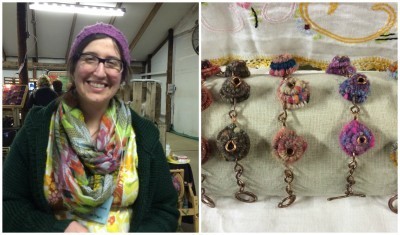
Bricolage! One of her necklaces may have come home with me.
March 27, 2015
Evangelina: Stitch-Maps Charts
Today’s post comes from guest writer, JC Briar, developer of the Stitch-Maps charting tool. She’s written for us before, and her clever tool permits interesting and illuminating analysis of complex stitch patterns and their behaviour.
Checking out the charts in the latest Knitty, I was struck by the charts for Evangelina.
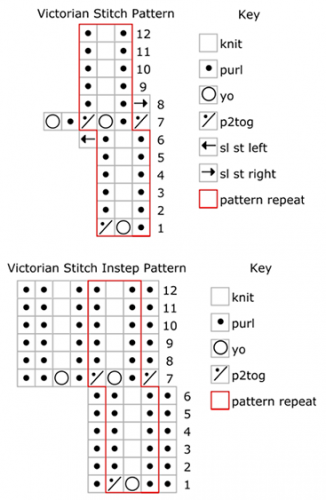
Evangelina’s Victorian Stitch Pattern is so clean and pretty. Did its charts have to be so disjointed? In particular, was it really necessary to slip stitches across the beginning-of-rounds marker at the end of round 6 and at the beginning of round 8?
To better understand the stitch pattern, I drew a stitch map for its instep version – that is, the version that features edge stitches, in the form of purls worked at the edges of Evangelina’s instep.
With the stitch pattern’s original red repeat boxes overlaid on top, we can see where the repeat shifts at the beginning of round 7. At that point, markers placed between repeats have to shift one stitch to the left, out of the way of the p2tog on round 7.
But is this the only way to define the pattern’s repeat? Viewing the stitch map again with column guides tracing the stitch columns, it’s possible to visualize a more convenient repeat for the pattern.
Markers placed between these repeats would run between stitch columns, and would never need to shift.
Going a step further and discarding the edge stitches, we come up with an alternate way to work the pattern on Evangelina’s leg.
Voilà! The beginning-of-rounds marker can stay put.
Truthfully? The more I play with stitch maps, the more certain I become that almost all stitch patterns can be worked in the round without ever having to shift the beginning-of-rounds marker. It’s all a matter of paying attention to the stitch columns, and defining the pattern’s repeat in accord with those stitch columns.
March 25, 2015
WWW: The Gay Sweater Project; The Skein Minder; If You Were a Yarn…
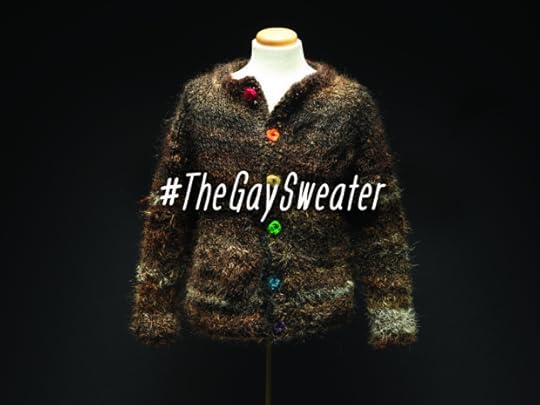
A clear message, communicated in a fascinating way.
Like all good art, The Gay Sweater Project is unexpected, challenging, and thought-provoking. In a bid to make people think about the the use of the term ‘gay’ as a derogatory descriptor, advertising agency Saatchi Canada collaborated with the Canadian Center for Gender & Sexual Diversity on a recent project.
In their own words…
The Gay Sweater project teaches us that words like ‘gay’ shouldn’t be used to describe anything negative. Please help the Canadian Centre for Gender & Sexual Diversity in continuing initiatives like these that work to eliminate bullying, homophobia, transphobia, and other forms of discrimination in schools and youth communities.
The Gay Sweater is indeed the only gay object in the world, in that it was created from the hair of over 100 people who identify as homosexual. The hair was spun and then knit into a sweater by two Toronto knitters, Amelia Lyon and Brenna MacDonald, at Lettuce Knit.
Oh, I like this: a Kickstarter for a tool called The SkeinMinder to automate yarn winding. It’s targeted at indie dyers, and those who need to wind multiple skeins of yarn in a small production environment. Although this technology exists for large-scale operation, engineer and knitter Carrie Sundra aims to bring the idea to small organizations, in an affordable way.
Also useful: Sally Holt, the developer of KnitCompanion, has just launched Pattern Genius, a charting tool for iPads.
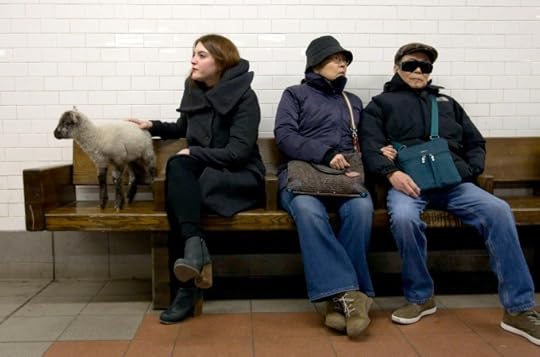
It’s true. You can see everything on the NYC subway.
I have to be honest: I checked the publication date for this one, thinking it might have been April 1st.
An orphaned lamb has been taken in by a foster family in NYC, and has been enjoying life in the big city. Even if it’s not real, the photos are great!
Not news: knitting is good for you. But I do like that formal research studies are being done on the topic of “textile therapy”.
And for your amusement, designer Bristol Ivy poses a fun question on Twitter:
Discussion question! If you were a yarn, what yarn would you be? This is a trickier question than I thought it would be!
— Bristol (@BristolIvy) March 23, 2015
If you click on the time and date in the tweet above, you can see all the fun replies.
Mandy Moore's Blog
- Mandy Moore's profile
- 6 followers


